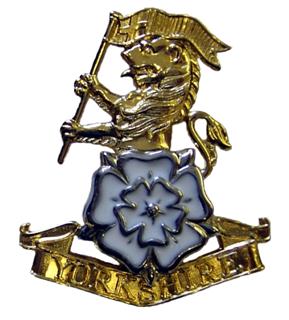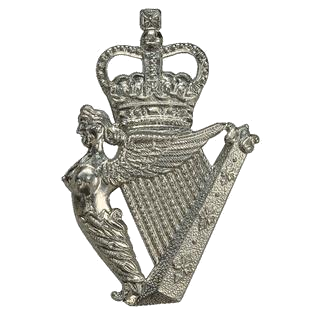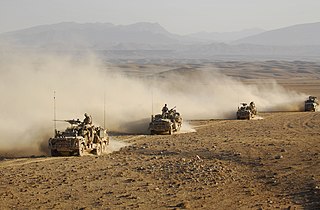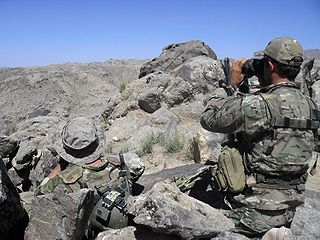
The 1st Commando Regiment is an Australian Army Reserve special forces unit, part of Special Operations Command with an integrated structure of regular (full-time) soldiers and reserve (part-time) soldiers, which together with the full-time Australian Army 2nd Commando Regiment, provides the commando capability to Special Operations Command. Raised in 1955 it is the oldest unit within Special Operations Command and in 2008 deployed to Afghanistan to become the first Australian Army Reserve force element on combat operations since World War II.

The Australian contribution to the war in Afghanistan has been known as Operation Slipper (2001–2014) and Operation Highroad (2015-2021).

The Royal Australian Regiment (RAR) is the parent administrative regiment for regular infantry battalions of the Australian Army and is the senior infantry regiment of the Royal Australian Infantry Corps. It was originally formed in 1948 as a three battalion regiment; however, since then its size has fluctuated as battalions have been raised, amalgamated or disbanded in accordance with the Australian government's strategic requirements. Currently, the regiment consists of seven battalions and has fulfilled various roles including those of light, parachute, motorised and mechanised infantry. Throughout its existence, units of the Royal Australian Regiment have deployed on operations in Japan, Korea, Malaya, Borneo, Vietnam, Somalia, Rwanda, Cambodia, East Timor, the Solomon Islands, Iraq and Afghanistan.

The Yorkshire Regiment is an infantry regiment of the British Army, created by the amalgamation of three historic regiments in 2006. It lost one battalion as part of the Army 2020 defence review. The regiment's recruitment area covers the ceremonial counties of the East Riding of Yorkshire, North Yorkshire, South Yorkshire and West Yorkshire; areas near Barnsley are recruitment area for the Rifles.

The Royal Irish Regiment is an infantry regiment of the British Army. The regiment was founded in 1992 through the amalgamation of the Royal Irish Rangers and the Ulster Defence Regiment. Their oldest predecessor, the 27th Regiment of Foot, was first raised in June 1689 to fight in the Williamite War in Ireland. Other notable regiments in their lineage include the Royal Inniskilling Fusiliers, Royal Irish Rifles and the Royal Irish Fusiliers.

The 3rd Battalion, The Royal Australian Regiment is a mechanised infantry battalion of the Australian Army, based in Kapyong Lines, Townsville as part of the 3rd Brigade. 3 RAR traces its lineage to 1945 and has seen operational service in Japan, Korea, Malaya, Borneo, South Vietnam, Rifle Company Butterworth, East Timor, the Solomon Islands, Afghanistan and Iraq.

The 2nd Battalion, Royal Australian Regiment is an amphibious light infantry battalion of the Australian Army part of the 1st Division Amphibious Task Group based at Lavarack Barracks in Townsville.
The Star of Gallantry (SG) is a military decoration awarded to personnel of the Australian Defence Force (ADF) and other persons recognised by the Minister for Defence. It is awarded for acts of great heroism or conspicuous gallantry in action in circumstances of great peril. It is the second highest of the military gallantry awards in the Australian Honours System, only surpassed by the Victoria Cross or Victoria Cross for Australia (VC).
The Medal for Gallantry (MG) is a military decoration awarded to personnel of the Australian Defence Force. It recognises acts of gallantry in action in hazardous circumstances. The MG was introduced on 15 January 1991, replacing the Imperial equivalent. It is ranked third in the Gallantry Decorations in the Australian Honours System. Recipients of the Medal of Gallantry are entitled to use the post-nominal letters "MG".

The United Kingdom was one of the first countries to take part in Operation Enduring Freedom against the Taliban regime in autumn 2001.

The 5th Battalion, Royal Australian Regiment is a regular motorised infantry battalion of the Australian Army. Originally established in 1965 it would serve two tours of South Vietnam before it was linked with the 7th Battalion to form the 5th/7th Battalion, Royal Australian Regiment in 1973. In late 2006 the two units were de-linked, and 5 RAR again joined the Australian Army's order of battle in its own right. It has since served in Iraq, East Timor and Afghanistan.

The 2nd Commando Regiment is a special forces unit of the Australian Army and is part of Special Operations Command. The regiment was established on 19 June 2009 when the 4th Battalion RAR (Commando) was renamed. It is based at Holsworthy, New South Wales. The 2nd Commando Regiment trains and has served with coalition special forces units, and is highly regarded by these units. The regiment has been involved in operations in East Timor, Iraq and Afghanistan, where it was used in a direct action warfighting role. It has also been involved in domestic security operations including the 2006 Commonwealth Games and the 2014 G20 Leaders Summit. In 2019, the regiment was made the Command's capability lead for strategic strike.
The Lae War Cemetery, established in 1944, is located adjacent to the Botanical Gardens in the centre of the city of Lae, the capital of Morobe Province, in Papua New Guinea. The cemetery is managed by the Commonwealth War Graves Commission.

Operation Perth was an Australian military operation in Orūzgān Province undertaken in July 2006 during the War in Afghanistan. The nine-day search and destroy operation occurred as part of a wider multi-national coalition operation to clear the Chora Valley, 40 kilometres (25 mi) north-east of Tarin Kowt, involving more than 500 troops from six nations, including the Netherlands Korps Commandotroepen. The operation was undertaken by the Australian Special Operations Task Group, including personnel from 4th Battalion, Royal Australian Regiment and the Special Air Service Regiment, under the command of Lieutenant Colonel Mark Smethurst. Fixed and rotary wing support was provided by a range of Coalition air assets, including Australian CH-47 Chinooks from the 5th Aviation Regiment. Heavy fighting with Taliban insurgents resulted, and during the intense combat the Australians fought their way through the valley, clearing it in a series of synchronised and closely coordinated operations. Despite meeting stiff resistance from several hundred insurgents, the operation was ultimately successful with the Taliban sustaining heavy casualties and eventually fleeing the valley.

The Shah Wali Kot Offensive was a five-day joint operation during the War in Afghanistan, conducted by Australian special forces and the Afghan National Army with US air support, between 10–14 June 2010. The operation took place in the Shah Wali Kot District of Kandahar Province, occurring in preparation for the coalition clearance of the province and resulting in heavy insurgent casualties.
The Battle of Derapet was fought near the village of Derapet in the Tangi Valley in Deh Rahwod, Orūzgān Province, southern Afghanistan, between a combined Australian Army and Afghan National Army patrol and Taliban forces on 24 August 2010. Australian forces had only recently taken over responsibility for Deh Rahwod as part of a major expansion of their area of operations which took place following the Dutch withdrawal from Afghanistan in August. The combined coalition patrol included 20 Australians and 20 Afghan National Army troops. The small Australian force from 1st Mentoring Task Force (MTF-1) based in Tarin Kowt included two sections of dismounted infantry and two ASLAV-25 guncars and was tasked with a fighting patrol to find and inflict damage on insurgent forces known to be in the area.
The First and Second Battles of Kakarak were fought near the village of Kakarak in the West Dorafshan district of Orūzgān Province, in southern Afghanistan. The fighting took place between Australian forces from the 1st Mentoring and Reconstruction Task Force (MRTF-1) and Taliban fighters, with the area considered to be one of the last Taliban outposts in the area. During the first action on the morning of 16 March a six-man Australian Operational Mentoring and Liaison Team (OMLT) operating with Afghan National Army (ANA) troops was contacted by a numerically superior Taliban force near the village. In the ensuing battle one Australian was killed before close air support from Dutch AH-64D Apache helicopter gunships and US aircraft allowed them to withdraw after inflicting heavy casualties on the Taliban insurgents.

Daniel Alan Keighran, is an Australian soldier and a recipient of the Victoria Cross for Australia, the highest award in the Australian honours system. Keighran was awarded the Victoria Cross for Australia for his actions in the Battle of Derapet on 24 August 2010, during the War in Afghanistan. He was presented with the medal by the Governor-General of Australia, Quentin Bryce, at a ceremony in Canberra on 1 November 2012. Keighran is the third soldier to be awarded the Victoria Cross for Australia, and the first member of the Royal Australian Regiment so awarded.

Mentoring Task Force One (MTF-1) was a combined arms battle group formed by the Australian Army for deployment as part of Operation Slipper during the War in Afghanistan. Formed in 2009 from the 7th Brigade, the unit consisted of infantry, engineers, cavalry, artillery and logistic elements from 55 different units, but was predominately based on the 6th Battalion, Royal Australian Regiment. Based at Forward Operating Base Ripley outside of Tarin Kowt in Uruzgan Province as part of a multinational brigade known as Combined Team Uruzgan, MTF-1 was tasked with counter-insurgency operations in conjunction with United States, Dutch and other coalition forces, operating from a number of patrol bases in the Mirabad, Baluchi and Chora valleys. MTF-1 served in Afghanistan from January to October 2010.
Cameron Stewart Baird, was a soldier in the Australian Army who was posthumously awarded the Victoria Cross for Australia, the highest award in the Australian honours system. Baird was the fourth person to receive the Victoria Cross for Australia during Operation Slipper.












